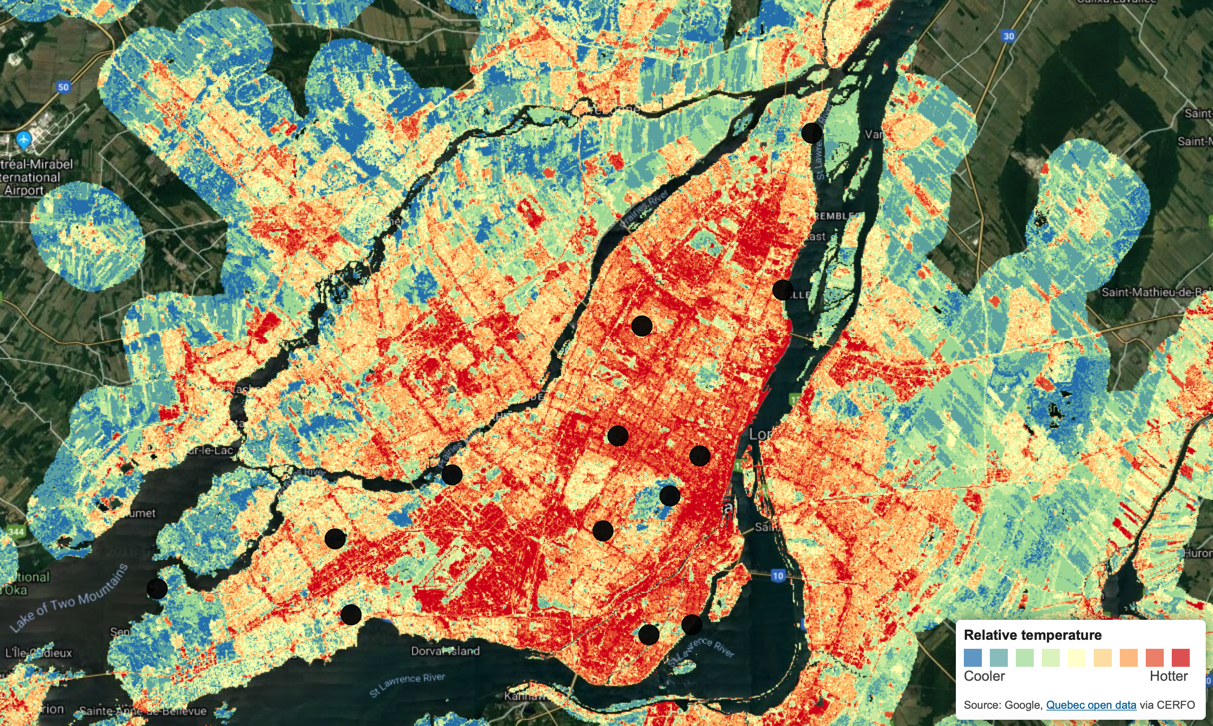Fellow Write as Rainers,
As per our English 301 instructions, I will practice the writing techniques for technical definitions by writing out three distinct types definitions, i.e. parenthetical, sentence, and expanded, on a relatively complex term used within my discipline: Geography. I have chosen the term urban heat island (UHI).
Parenthetical definition: Montréal is particularly susceptible to heat waves because approximately 28% of the surface of Montréal is covered by urban heat islands (areas within a city that are significantly warmer than the surrounding rural areas due to human activities).
Sentence definition: Urban heat islands are the areas within a metropolitan region that are significantly warmer than the surrounding rural regions due to the concentration of asphalt and concrete which traps in heat.
Expanded Definition:
What are Urban Heat Islands?
The term urban heat island (UHI) refers to a micro-climatic phenomenon that occurs in urban environments (Musco, 2016). More specifically, UHIs are the areas within a metropolitan region that are significantly warmer than the surrounding rural regions due to the concentration of asphalt and concrete which traps in heat. At the seasonal level, UHIs occur in winter as well as in summer, where they are far more severe for the population living in the urban environment. Contrary to popular belief, UHIs are not a direct consequence of climate change, rather they have been shown to be directly linked to the size of urban areas (Musco, 2016). Even though UHIs are not a product of climate change, they are expected to exacerbate the overall mean temperatures in the second half of the century due to the predicted warming in the climate change scenario framework (Musco, 2016).
Contributing factors
There are a number of contributing factors that cause UHIs such as the type of materials (i.e. bricks, stone, asphalt, tar, etc.), lack of vegetation, soil sealing, human activities (i.e. air conditioning, vehicle engines, and some industrial activities), and urban morphologies (i.e. narrow streets and tall buildings) (City of Montréal, 2017). Figure 1 shows a temperature map of the areas on the Island of Montréal that are hotter relative to the surrounding areas.

Figure 1. Temperature map of relative temperature differences on the Island of Montréal. Parks with tree cover are shown to be the coolest places on this map. The black circles represent the 13 sectors across Montreal that are both cool and contain a high percentage of tree coverage. Reproduced from CBC News, by R. Rocha, 2018, Retrieved from https://www.cbc.ca/news/canada/montreal/montreal-warm-cool-places-interactive-1.3669639
Heath impacts:
UHIs have the potential to directly influence the health and welfare of urban residents. Since UHIs are characterized by increased temperature, they can potentially increase the magnitude and duration of heat waves within cities. These increased temperatures have been reported to cause heat stroke, heat exhaustion, heat syncope, and heat cramps. This poses a particularly serious threat to young children and seniors, especially those who live alone or suffer from chronic illnesses. Furthermore, socioeconomic factors influence the vulnerability of citizens facing higher risks from oppressive heat conditions. Specifically, air conditioning is often not accessible to those in lower socioeconomic conditions (City of Montréal, 2017), which reflects severe social inequalities within cities.
Mitigation:
There are several mitigation strategies that are widely used in cities experiencing effects from UHIs. Some of these strategies include:
- White roofs: Painting rooftops white has become a popular strategy for reducing UHI effects. In cities, there are many dark coloured surfaces that absorb the heat of the sun which results in lowering the albedo of the city and increasing the overall temperature. White rooftops allow high solar reflectance and high solar emittance, which increases the albedo of the city or area and reduces the overall temperature the UHI effect is occurring (Zinzi & Agnoli 2012).
- Green roofs: Green roofs are another strategy for reducing the UHI effect. Green roofery is the practice of having vegetation on a roof; such as having trees or a garden. The plants that are on the roof increase the albedo and decreases the urban heat island effect (Zinzi & Agnoli 2012).
- Planting trees in cities: Planting trees around the city can be another way of increasing albedo and decreasing the UHI effect. It is recommended to plant deciduous trees because they can provide many benefits such as more shade in the summer and not blocking warmth in winter (Rosenfeld, Romm, Akbari & Lloyd, 1997).
- Green parking lots: Green parking lots use surfaces other than asphalt and vegetation to limit the impact urban heat island effect.
References
City of Montréal. (2017). Climate change adaptation plan for the Montréal urban agglomeration 2015-2020: Summary Version 2017 Edition. Retrieved from http://ville.montreal.qc.ca
Musco, F. (Ed.). (2016). Counteracting urban heat island effects in a global climate change scenario. Cham, Switzerland: Springer International Publishing.
Rocha, R. (2018, July 4). Where are the warmest and the coolest places in Montreal? CBC News. Retrieved from https://www.cbc.ca
Rosenfeld, A. H., Romm, J. J., Akbari, H., & Lloyd, A. C. (1997). Painting the town white–and green. MIT’s Technology Review, 100(2), 52.
Zinzi, M., & Agnoli, S. (2012). Cool and green roofs. an energy and comfort comparison between passive cooling and mitigation urban heat island techniques for residential buildings in the Mediterranean region. Energy & Buildings, 55, 66-76. doi:10.1016/j.enbuild.2011.09.024
Leave a Reply